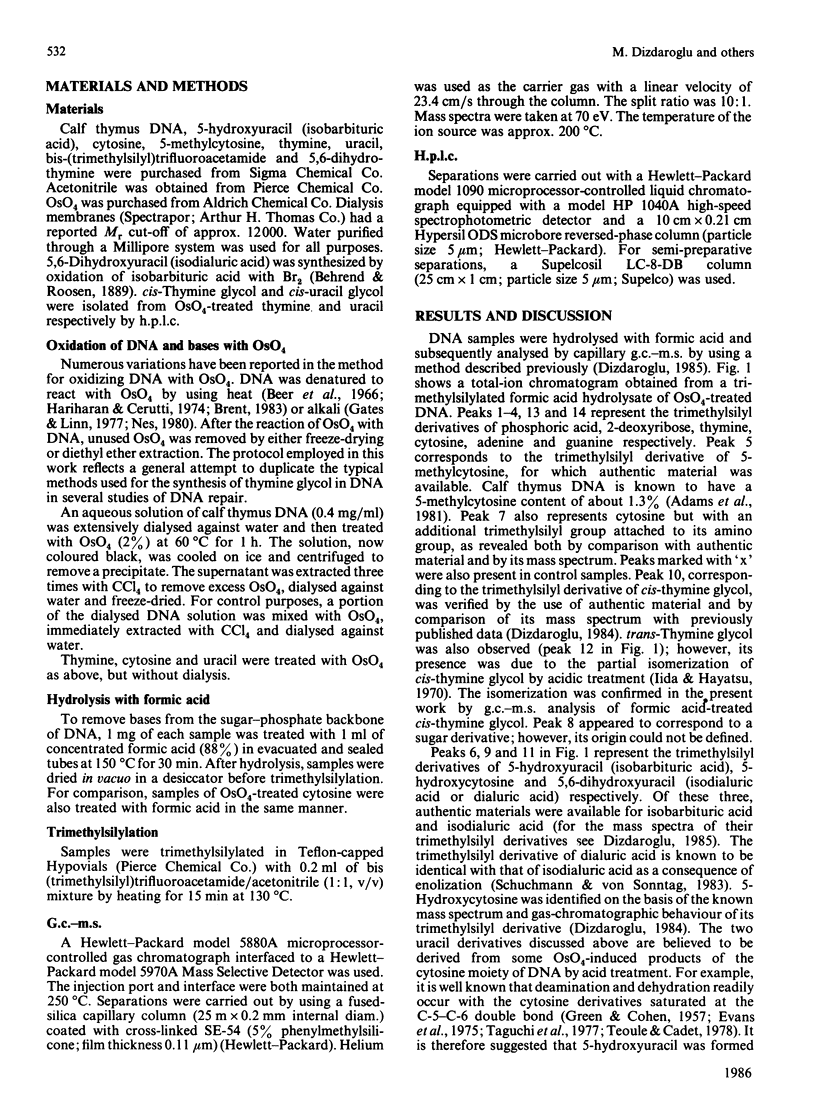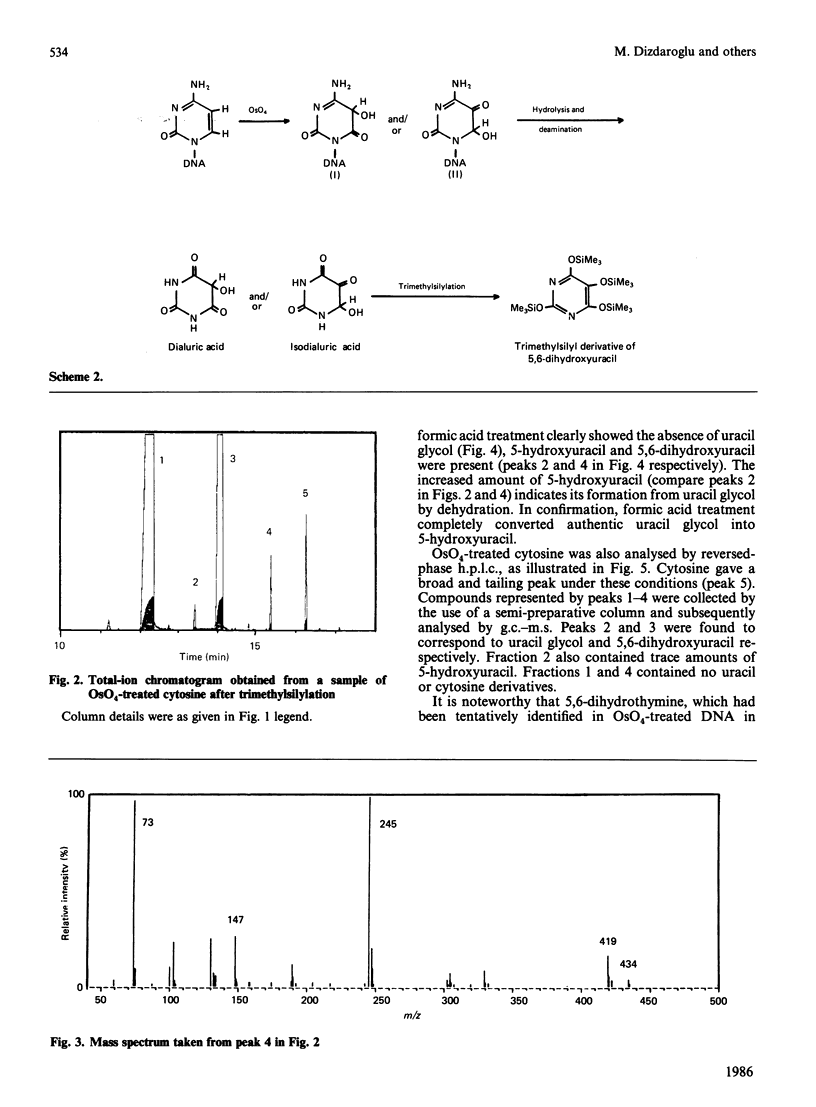Abstract
OsO4 selectively forms thymine glycol lesions in DNA. In the past, OsO4-treated DNA has been used as a substrate in studies of DNA repair utilizing base-excision repair enzymes such as DNA glycosylases. There is, however, no information available on the chemical identity of other OsO4-induced base lesions in DNA. A complete knowledge of such DNA lesions may be of importance for repair studies. Using a methodology developed recently for characterization of oxidative base damage in DNA, we provide evidence for the formation of cytosine glycol and 5,6-dihydroxycytosine moieties, in addition to thymine glycol, in DNA on treatment with OsO4. For this purpose, samples of OsO4-treated DNA were hydrolysed with formic acid, then trimethylsilylated and analysed by capillary gas chromatography-mass spectrometry. In addition to thymine glycol, 5-hydroxyuracil (isobarbituric acid), 5-hydroxycytosine and 5,6-dihydroxyuracil (isodialuric acid or dialuric acid) were identified in OsO4-treated DNA. It is suggested that 5-hydroxyuracil was formed by formic acid-induced deamination and dehydration of cytosine glycol, which was the actual oxidation product of the cytosine moiety in DNA. 5-Hydroxycytosine obviously resulted from dehydration of cytosine glycol, and 5,6-dihydroxyuracil from deamination of 5,6-dihydroxycytosine. This scheme was supported by the presence of 5-hydroxyuracil, uracil glycol and 5,6-dihydroxyuracil in OsO4-treated cytosine. Treatment of OsO4-treated cytosine with formic acid caused the complete conversion of uracil glycol into 5-hydroxyuracil. The implications of these findings relative to studies of DNA repair are discussed.
Full text
PDF





Selected References
These references are in PubMed. This may not be the complete list of references from this article.
- Ames B. N. Dietary carcinogens and anticarcinogens. Oxygen radicals and degenerative diseases. Science. 1983 Sep 23;221(4617):1256–1264. doi: 10.1126/science.6351251. [DOI] [PubMed] [Google Scholar]
- Beer M., Stern S., Carmalt D., Mohlhenrich K. H. Determination of base sequence in nucleic acids with the electron microscope. V. The thymine-specific reactions of osmium tetroxide with deoxyribonucleic acid and its components. Biochemistry. 1966 Jul;5(7):2283–2288. doi: 10.1021/bi00871a017. [DOI] [PubMed] [Google Scholar]
- Brent T. P. Properties of a human lymphoblast AP-endonuclease associated with activity for DNA damaged by ultraviolet light, gamma-rays, or osmium tetroxide. Biochemistry. 1983 Sep 13;22(19):4507–4512. doi: 10.1021/bi00288a024. [DOI] [PubMed] [Google Scholar]
- Burton K., Riley W. T. Selective degradation of thymidine and thymine deoxynucleotides. Biochem J. 1966 Jan;98(1):70–77. doi: 10.1042/bj0980070. [DOI] [PMC free article] [PubMed] [Google Scholar]
- Cerutti P. A. Prooxidant states and tumor promotion. Science. 1985 Jan 25;227(4685):375–381. doi: 10.1126/science.2981433. [DOI] [PubMed] [Google Scholar]
- Choo-Kang E., McDonald H., McDonald J., Chang H. Estimation of a reference range for immunoglobulins by a turbidimetric method. West Indian Med J. 1981 Jun;30(2):77–80. [PubMed] [Google Scholar]
- Darby G. K., Jones A. S., Tittensor J. R., Walker R. T. Chemical degradation of DNA oxidized by permanganate. Nature. 1967 Nov 25;216(5117):793–794. doi: 10.1038/216793a0. [DOI] [PubMed] [Google Scholar]
- Demple B., Linn S. DNA N-glycosylases and UV repair. Nature. 1980 Sep 18;287(5779):203–208. doi: 10.1038/287203a0. [DOI] [PubMed] [Google Scholar]
- Dizdaroglu M. Application of capillary gas chromatography-mass spectrometry to chemical characterization of radiation-induced base damage of DNA: implications for assessing DNA repair processes. Anal Biochem. 1985 Feb 1;144(2):593–603. doi: 10.1016/0003-2697(85)90158-7. [DOI] [PubMed] [Google Scholar]
- Dizdaroglu M. The use of capillary gas chromatography-mass spectrometry for identification of radiation-induced DNA base damage and DNA base-amino acid cross-links. J Chromatogr. 1984 Jul 6;295(1):103–121. doi: 10.1016/s0021-9673(01)87602-0. [DOI] [PubMed] [Google Scholar]
- Evans B. E., Mitchell G. N., Wolfenden R. The action of bacterial cytidine deaminase on 5,6-dihydrocytidine. Biochemistry. 1975 Feb 11;14(3):621–624. doi: 10.1021/bi00674a024. [DOI] [PubMed] [Google Scholar]
- Frenkel K., Goldstein M. S., Duker N. J., Teebor G. W. Identification of the cis-thymine glycol moiety in oxidized deoxyribonucleic acid. Biochemistry. 1981 Feb 17;20(4):750–754. doi: 10.1021/bi00507a014. [DOI] [PubMed] [Google Scholar]
- GREEN M., COHEN S. S. Studies on the biosynthesis of bacterial and viral pyrimidines. II. Derivatives of dihydrocytosine. J Biol Chem. 1957 Oct;228(2):601–609. [PubMed] [Google Scholar]
- Gates F. T., Linn S. Endonuclease from Escherichia coli that acts specifically upon duplex DNA damaged by ultraviolet light, osmium tetroxide, acid, or x-rays. J Biol Chem. 1977 May 10;252(9):2802–2807. [PubMed] [Google Scholar]
- Hariharan P. V., Cerutti P. A. Excision of damaged thymine residues from gamma-irradiated poly(dA-dT) by crude extracts of Escherichia coli. Proc Natl Acad Sci U S A. 1974 Sep;71(9):3532–3536. doi: 10.1073/pnas.71.9.3532. [DOI] [PMC free article] [PubMed] [Google Scholar]
- Iida S., Hayatsu H. The permanganate oxidation of thymine. Biochim Biophys Acta. 1970 Jul 16;213(1):1–13. doi: 10.1016/0005-2787(70)90002-x. [DOI] [PubMed] [Google Scholar]
- Nes I. F. Purification and properties of a mouse-cell DNA-repair endonuclease, which recognizes lesions in DNA induced by ultraviolet light, depurination, gamma-rays, and OsO4 treatment. Eur J Biochem. 1980 Nov;112(1):161–168. doi: 10.1111/j.1432-1033.1980.tb04997.x. [DOI] [PubMed] [Google Scholar]


